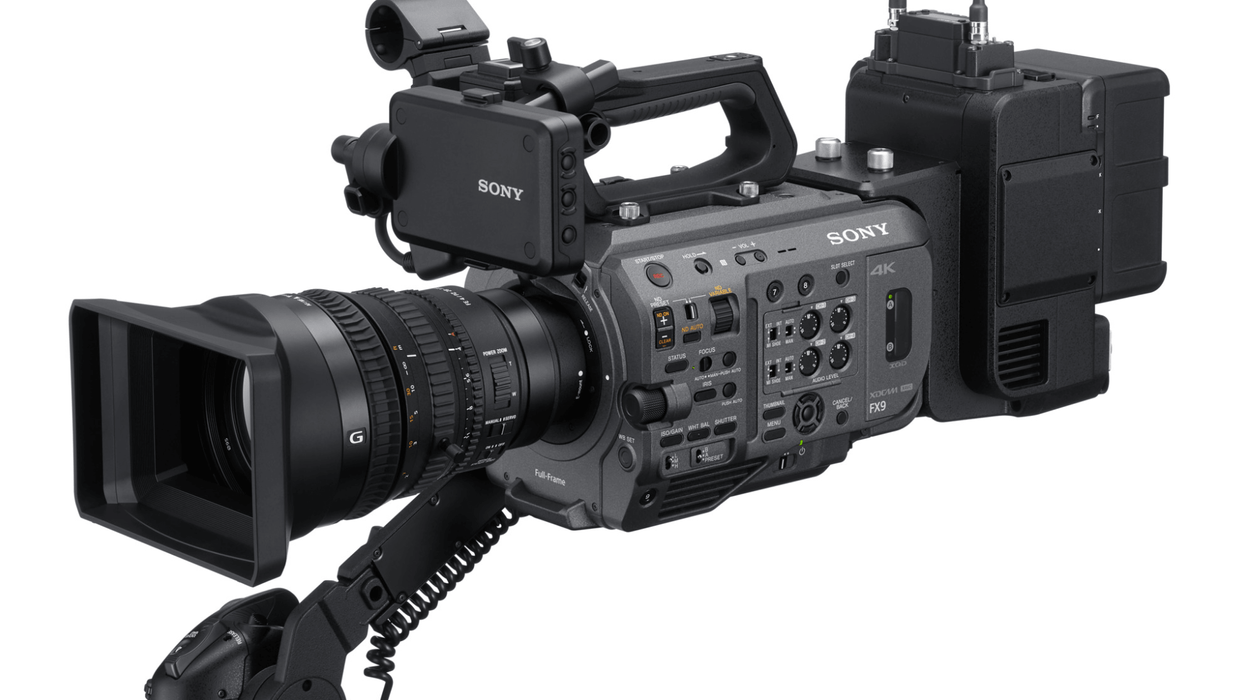The Sony FX9 is Here and it Does Something No Pro Video Camera Has Done Before
Sony announces both the FX9 and Z750 professional video cameras.

What would you get if you threw a boatload of Sony Venice and A9 parts on a table and challenged Sony engineers to make a run and gun camera? Well, the answer is the follow up to the popular FS7 line. And it’s called the Sony FX9. Designed with the best technologies from the VENICE and A9, the new FS9 has roughly the same basic run and gun style body as the previous FS7 line, but with some notable improvements. Sony also announced the more TV-centric Z750 complete with 12GSDI and wireless capability. Let's take a look.
In what Sony calls a "world's first," the FX9 has a variable electronic neutral density filter that can be controlled from a hard dial on the side of the camera.
Sony FX9
Sensor
Under the hood, the Sony PXW-FX9 has a back-illuminated full-frame 6K Exmor R image sensor that oversamples 6008 x 3168 resolution to create its 4K images capable of full HDR. For those keeping tabs the VENICE oversamples its 6K at 6048 x 4032. Sony says the Exmor R sensor provides 15+ stops of dynamic range and has a dual base ISO at 800 and 4000. (VENICE dual base ISO 500 and 2500).
Like VENICE, the FX9 includes S-Log 3 and S-Gamut 3 Cine but Sony added a new color science called S-Cinetone that's said to have a more accurate color gamut and skin tones for a better cinematic look. The footage we were shown using S-Cinetone did have less of a video feel to it but still walked that Sony visual palette. The camera is Netflix approved.
Sony added a new color science called S-Cinetone that's said to have a more accurate color gamut and skin tones for a better cinematic look
Fast Hybrid AF & Face Detection
Sony included the fast autofocus systems we find on its popular Alpha series cameras. The Fast Hybrid AF has 561 focus points covering 94% in the horizontal and 96% in the vertical in full-frame mode. Sony also added in face detection for filmmakers with the ability to choose and track your subject by setting it with the touchscreen LCD.
Variable Electronic ND Filter
In what Sony calls a "world's first," the FX9 has a variable electronic neutral density filter that can be controlled from a hard dial on the side of the camera. You'll also notice several other hard dials there, covering functions for customizable ND filter presets, dual-channel audio adjustment, Iris control, white balance, and shutter. This is a nice addition since it eliminates what Sony calls "Menu hunting" for the right setting, wasting time on set. And it's got a cool old-school vibe.
.
Recording Modes
The FX9 is capable of shooting 4K full-frame (3840 x 2160) at 24p/25p/30p or S35 (3840 x 2160) at 24p/25p/30p/60p. A future firmware update will add 4K (4096 x 2160) and 60fps in full-frame mode and in S35 will see 24p/25p/30p/60p at 4096 x 2160.
High frame rates of 100/120fps are supported in 1080p full-frame and S35. In a future update, 150/180fps will be added in 1080p and S35 will see 3840 x 2160 get 100/120fps.
Build
The FX9 keeps the same run and gun style body as the FS7 with an E- mount lens mount and includes a slew of quick menu options on the side of the camera. Sony also added in 4 separate channels of audio.
Other refinements include genlock timecode in/out on the body. Electronic viewfinder design can be changed to have a sunshade and the grip is more compact – merging the best features from the FS5 and FS7 grips.
FX9 Future Plans
Sony has laid out plans for its future which will include 16bit RAW output, 4K60p recording in full-frame mode, full HD 180fps in 6K full-frame mode and DCI 4K recording. The firmware update was suggested to hit summer 2020 but nothing is confirmed.
Sony also showed us an optional XDCA External mount module, which offers the following connections:
- RJ45 ethernet
- dual-link streaming
- DWX slot in for wireless audio (future firmware update)
- DTAP power
- V mount battery support
Price and Availability
The target price for the FX9 starts at $`10,999, $13,499 for the kit, which includes an A-mount 28-135 kit lens. Shipping starts next summer. The XDCA Unit will be available in January 2020 for $2499.
Sony Z750 Camcorder
Other specs include:
- 2/3" 4K 3 chip CMOS image sensor
- global shutter
- 4:2:2 10 bit
- HDR and S-Log3
- 4K/HD simultaneous recording
- HFR up to 120p in HD
- XAVC-L 422 200M codec
- VPID interface
- 12G-SDI
- Built-in wireless streaming to the internet
That's pretty much all we were told about the Z750, which looks like it'll be very popular with television news crews. It will be available in February 2020. Price is TBD.
Sneak Peek: Cinema Lens Series
Sony also gave us a sneak peek of their new Cinema Lens Series of lenses. The three lens set starts off with the E-Mount FEC 16-35 T3.1. It covers the entire full frame of the image sensor, up to 96% coverage, and has power zoom. Here it is up close and personal:

I like having a constant aperture speed in a zoom lens, an at T3.1, that's going to be a very high performing piece of glass. Being Sony, the lens line will only available in E-Mount. There are no plans to create their own lens mount adapter, but they did tell us that Metabones adapters will support their lenses.
Price for the first FE C 16-35 is targeted at $5,500 and will be available this Spring.



















